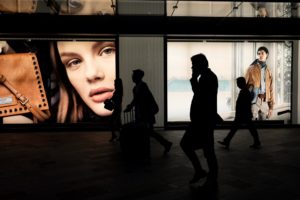The introduction of technology was a double-edged sword for so many industries. In retail the trend continues, with some retailers embracing the online demands of their consumers while others are forced to cut losses and close their brick and mortar stores.
Now, the sharing economy is poised to disrupt retail. From ride sharing and home sharing to service sharing, the sharing economy has finally extended out to consumer goods, causing retail—still reeling from consumers’ shift to digital—to wonder how they’re going to be impacted.

Access vs. ownership
The sharing economy highlights the demand for access. Consumers want access to goods and services that they may not otherwise be able to afford, or perhaps just do not want to own forever. Simply put, consumers want options.
Why buy a dress for a single event that you know you’ll never wear again? The answer: you don’t. Not when platforms like Rent the Runway allow you to rent an outfit for an occasion and return it when done.
An opportunity for retailers
While many retailers may feel that they have missed the boat or are unable to compete with the cool new tech startups leading this space, there is research to suggest otherwise. Boston Consulting Group surveyedconsumers to gauge the opportunities presented by the sharing economy, consumer attitudes, and the industries that will be affected.
They found that 53% of US respondents would prefer dealing with established businesses in the sharing economy, versus only 21% who prefer dealing directly with peers. This highlights a huge opportunity for retailers to participate in the sharing economy and compete with peer-to-peer players.
What does this mean? Retailers who see and seek out the opportunities in disruption will thrive. Those who don’t, will not.

Know your demographic
Today’s consumers—those driving the sharing economy—are unique, tech-savvy, and have high expectations of both the purchasing experience and the services they’ve purchased.
Here are 5 ways retailers can appease the needs of this demographic and effectively compete with competitors in the sharing economy:
1. Personalization is expected
Modern consumers expect customization, co-creation, and on-demand products. Retailers must look at their offerings to see how they are delivering a personalized experience—through better data capture and customer profiling—to make customers feel like this service is designed specifically for them.
2. Mobile experience is key
Consumers are now in the habit of getting whatever they want with a tap. For retailers, if the mobile experience is not intuitive, they can’t compete. Retailers need to take a look at their mobile experience and invest in it in order to give customers the kind of experience they want and expect.
3. No more one-size-fits-all model
Historically, retailers would buy stock and market it in the same way to everyone, but this doesn’t cut it anymore—not every consumer is the same. Different products serve different purposes for different people depending on where they are in life. Messaging and product offerings need to be tailored to what the target consumer wants and where they are in the purchase funnel.

4. Trust is earned
Customers today need to be wooed. They don’t give their trust to brands freely. Millennials in particular like to try before they buy to ensure that the product they’re purchasing will do what’s promised. They are extremely thrifty with purchases and lean heavily on the advice of their peers, leveraging UGC for insight into product quality. Sephora is one business succeeding in giving this demographic what they want, allowing consumers to try products before purchasing.
Retailers should look at subscription services to get their products in front of more potential customers, building trust and increasing brand loyalty in the process.
5. Speed is key
There are some retailers, like Zazzle, who connect local makers and manufacturers around the to their platform. Through this kind of localization, they’re able to offer quick turnaround times for their customers, which is particularly necessary in today’s Amazon-first world. Because of their decentralized production process, they’re also able to react to trends while they’re still relevant, getting their customers what they want, when they want it, faster than most. By focusing on localization, they’re able to scale and be responsive.

It’s not all doom and gloom
The sharing economy is not taking over retail in the same way that Lyft/Uber disrupted the taxi industry. What it has done is shifted what consumers expect. Retailers can’t dictate to their customers anymore, and previously untouchable behemoths have been forced into a position of humility. But hope is not lost. By listening to and evolving with consumers, retail will avoid dying a slow death.



